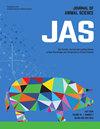学生视角:批判性思维和动物农业面临的问题
IF 2.9
2区 农林科学
Q1 AGRICULTURE, DAIRY & ANIMAL SCIENCE
引用次数: 0
摘要
这篇摘要的作者怀疑学生对动物农业面临的问题的了解,以及他们批判性地评估有关动物农业的社交媒体参考的能力。调查样本提供的观察结果是概念化学生认为与动物农业相关的重要兴趣领域,他们如何从获得信息的地方巩固他们的知识,以及是什么构成了他们做出这些结论的推理。因此,研究人员要求49名动物科学专业的本科生(n=49)定义批判性思维(CT),并使用这种思维过程来识别他们认为动物农业(AA)面临的当前问题。大多数学生认为批判性思维包括通过头脑风暴或“跳出框框”思考来进一步评估思想/概念或信息。而另一些人则认为批判性思维包括运用他们的知识来提出解决方案。虽然学生们在巩固知识和经验的道路上,但没有人提到使用事实搜索来获取额外的信息来形成观点/答案。这就产生了这样的问题:学生是否仅仅通过个人理解来接近感兴趣的主题,或者他们是否利用高等教育的资源,如科学文献,来完善他们对主题的理解,从而得出结论。此外,被调查的学生被要求运用他们的批判性思维技能,并按照重要性列出与动物农业(AA)有关的五个问题。正如预期的那样,记录的问题有变化,但它们表明了与受过教育的群体一致的复杂程度,而其他主题在AA领域中几乎没有意义,并被归类为情感或社会驱动。虽然数据提供了广泛的当前AA问题,但九个中心主题演变。回答最多的是“经济”(29.24%)、“环境”(21.64%)、“生产可持续性”(11.7%)等一般话题。较少选择的主题包括动物行动主义(9.94%)、动物健康(8.77%)和动物福利(6.43%),而不知情人口(4.09%)和食品安全(1.75%)最不可能被列出。值得注意的是,学生们表现出的品质与批判性思维需要头脑风暴概念的信念是一致的,这一点在AA问题中列出的各种主题中都很明显,然而,许多人也偏离了问题,列出了社会问题,而不是AA特有的问题,这与之前的研究相似,即学生利用不可靠的媒体来源(Reddit, Facebook, Instagram等)作为他们的全球信息来源。因此,我们可以观察到,学生们在互助会中发现了相关的问题,但我们必须认识到他们花在获取无效或不可靠的信息来源上的时间,这些信息往往被媒体忽视或歪曲,可能会培养出一种缺乏批判性思维过程的环境。本文章由计算机程序翻译,如有差异,请以英文原文为准。
7 Student Perspective: Critical thinking and issues facing animal agriculture
The authors of this abstract were skeptical of students’ knowledge of issues facing animal agriculture and equally their ability to critically evaluate social media references with regards to animal agriculture. The observations for which the surveyed samples offer is to conceptualize what students deemed vital areas of interest in correlation to animal agriculture, how they consolidate their knowledge from where their information was obtained, and what constituted their reasoning to make those conclusions. Therefore, undergraduate animal science majors enrolled (n=49) in a junior-level animal science course were asked to define critical thinking (CT) and use this thought process to identify what they perceived as current issues facing Animal Agriculture (AA). Most students believed critical thinking involves further evaluation of a thought/concept or information through brainstorming or thinking ‘outside of the box’. While others believed that critical thinking involved using their knowledge to come up with a solution. Though students were on the path of consolidating knowledge and experiences, none mentioned using fact finding searches for additional information to formulate an opinion/answer. This gives rise to questions of whether students approach topics of interest solely through personal understanding, or if they utilized sources from higher education such as scientific literature to refine their understanding of topics to make conclusions. Additionally, the surveyed students were asked to use their critical thinking skills and list, in order of importance, five issues pertaining to Animal Agriculture (AA). As would be expected, there were variations of recorded issues, yet they indicated a level of sophistication congruent with educated groups while other topics yielded little to no significance within the field of AA and categorized as emotional or socially driven. Though the data provided a wide spectrum of current AA issues, nine central themes evolved. The highest responses were general topics of Economy (29.24%), Environment (21.64%), and Production Sustainability (11.7%). Lesser chosen themes included Animal Activism (9.94%), Animal Health (8.77%), and Animal Welfare (6.43%), with Uninformed Population (4.09%) and Food Safety (1.75%) the least likely to be listed. It is informative that the students exhibited qualities congruent to the belief that critical thinking entails brainstorming concepts as is evident to the wide variety of topics listed of AA Issues, however, many also deviated from the question and listed societal issues rather than those specific to AA which parallels previous research of which students utilize unreliable media sources (Reddit, Facebook, Instagram, etc.) for their source of global information. Therefore, it could be observed that students identified issues in AA that were relevant, but we must be cognitive the amount of time they spend accessing invalid or unreliable sources, which often are overlooked or misrepresented by media sources and could foster an environment of poor critical thinking process.
求助全文
通过发布文献求助,成功后即可免费获取论文全文。
去求助
来源期刊

Journal of animal science
农林科学-奶制品与动物科学
CiteScore
4.80
自引率
12.10%
发文量
1589
审稿时长
3 months
期刊介绍:
The Journal of Animal Science (JAS) is the premier journal for animal science and serves as the leading source of new knowledge and perspective in this area. JAS publishes more than 500 fully reviewed research articles, invited reviews, technical notes, and letters to the editor each year.
Articles published in JAS encompass a broad range of research topics in animal production and fundamental aspects of genetics, nutrition, physiology, and preparation and utilization of animal products. Articles typically report research with beef cattle, companion animals, goats, horses, pigs, and sheep; however, studies involving other farm animals, aquatic and wildlife species, and laboratory animal species that address fundamental questions related to livestock and companion animal biology will be considered for publication.
 求助内容:
求助内容: 应助结果提醒方式:
应助结果提醒方式:


